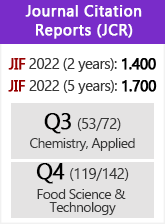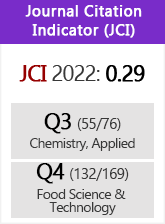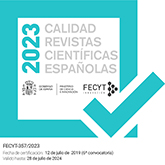Relationship between changes in peroxide value and conjugated dienes during oxidation of sunflower oils with different degree of unsaturation
DOI:
https://doi.org/10.3989/gya.096908Keywords:
Conjugated dienes, Fatty acids, Hydroperoxides, Methyl linoleate, Oxidation, Peroxide valueAbstract
Peroxide value and the determination of conjugated dienes by UV absorption at 232 nm are normally applied alternatively for the evaluation of primary oxidation compounds. The objective of this study was to define the relationship between both indexes during oil oxidation in sunflower oils with different degree of unsaturation. The oils studied were conventional sunflower oil (SO) and high oleic sunflower oil (HOSO). For comparative purposes, methyl linoleate, whose hydroperoxides are conjugated diene hydroperoxides, was also studied. Samples were oxidized at 40 °C in the dark. In order to accelerate oxidation at 40 °C, the natural antioxidants present in the oils were removed, and a high surface to oil volume ratio (0.8 cm-1) was applied to guarantee total air availability. Linear regressions with high correlation coefficients between peroxide values and conjugated dienes were found for the three lipid systems studied (0.9988, 0.9991 and 0.9977 for methyl linoleate, SO and HOSO, respectively). Significant differences in the slopes of the lines were found (0.0974, 0.0854 and 0.0503 for methyl linoleate, SO and HOSO, respectively), indicating the formation of non-conjugated hydroperoxides from oleic acid in the oils, even in the oxidation of SO with a high degree of unsaturation. Consequently, only peroxide value would be reliable for the evaluation of primary oxidation compounds in oils of different degree of unsaturation, unless adequate calibration lines (peroxide value versus conjugated dienes) are applied.
Downloads
References
AOCS. 1998. Official methods and recommended practices of the American Oil Chemists’ Society (5th edition). Champaign, Illinois: American Oil Chemists’ Society, ed. D. Firestone.
Dobarganes MC, Pérez-Camino MC. 1988. Fatty acid composition: a useful tool for the determination of alteration level in heated fats. Rev. Franc. Corps Gras 35, 67-70.
Dobarganes MC, Velasco J. 2002. Analysis of Lipid Hydroperoxides.- Eur. J. Lipid Sci. Technol. 104, 420-428. doi:10.1002/1438-9312(200207)104:7<420::AID-EJLT420>3.0.CO;2-N
Frankel E N. 2005. Methods to determine the extent of oxidation. In Lipid Oxidation, 2nd Edition, The Oily Press, England, 99-127.
IUPAC.1992. Standard methods for the analysis of oils fats and derivatives, 1st supplement to 7th edition. International Union of Pure and Applied Chemistry. Pergamon Press, Oxford.
Márquez-Ruiz G, Martín-Polvillo M, Dobarganes MC. 1996. Quantitation of oxidized triglyceride monomers and dimers as an useful measurement for early and advanced stages of oxidation, Grasas y Aceites, 47, 48-53.
Martín-Polvillo M. Márquez-Ruiz G, Dobarganes M C. 2004. Oxidative stability of sunflower oils differing in unsaturation degree during long-term storage at room temperature. J. Am. Oil Chem. Soc. 81, 577-583.doi:10.1007/s11746-006-0944-1
Rodrigues Machado E, Marmesat S, Abrantes S, Dobarganes M C. 2007. Uncontrolled variables in frying studies: differences in repeatability between thermoxidation and frying experiments. Grasas y Aceites 58, 283-288. doi:10.3989/gya.2007.v58.i3.184
Yoshida H, Kondo I, Kajimoto G. 1992. Participation of free fatty acids in the oxidation of purified soybean oil during microwave heating. J. Am. Oil Chem. Soc., 69, 1136-1140. doi:10.1007/BF02541050
Downloads
Published
How to Cite
Issue
Section
License
Copyright (c) 2009 Consejo Superior de Investigaciones Científicas (CSIC)

This work is licensed under a Creative Commons Attribution 4.0 International License.
© CSIC. Manuscripts published in both the printed and online versions of this Journal are the property of Consejo Superior de Investigaciones Científicas, and quoting this source is a requirement for any partial or full reproduction.All contents of this electronic edition, except where otherwise noted, are distributed under a “Creative Commons Attribution 4.0 International” (CC BY 4.0) License. You may read here the basic information and the legal text of the license. The indication of the CC BY 4.0 License must be expressly stated in this way when necessary.
Self-archiving in repositories, personal webpages or similar, of any version other than the published by the Editor, is not allowed.
















